In an environment where music permeates almost every aspect of daily life, from internet ads to TV shows, the question arises: should students be allowed to listen to music in class?
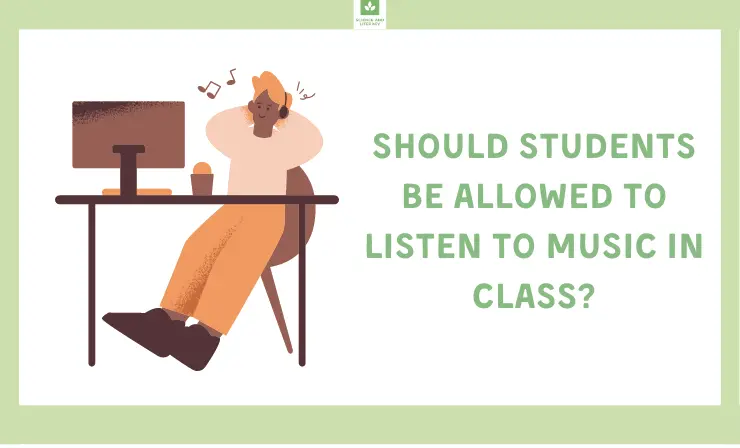
This practice reflects our students’ constant exposure to music, though its implementation in classrooms isn’t always driven by an understanding of its benefits. Yet, recalling those “cool” teachers who played the radio or allowed iPods in class, it’s evident they might have unintentionally tapped into the positive impacts of music in educational settings.
Research from committed educators like Kevin White suggests that having background music on during class helps students stay on task, monitor their behavior, and improve self-motivation. White’s research was done to answer the question of whether music in the classroom can be beneficial to students and the answer is…
Of course!
How many adults listen to music during work in the name of focus and productivity? Heck, I once listened to the same song six hours straight while I rushed to finish a term paper.
I *almost* forgot Twitter Tuesday. BUT I had to post our soothing Christmas vibe in the classroom lately. Listening to Christmas music while sitting in front of a fire and the lights dimmed. Makes for for the perfect learning environment 🎄🔥#oesrams pic.twitter.com/onnRKeUQAl
— Lauren Ward (@WardsWiseOwls85) December 9, 2020
But background music is only one tool in our arsenal; there are many, many others worth using and understanding. As a music educator, I’m thrilled to share what I know about the power of music and how it can be applied in the regular education classroom.
Here’s what I’ll discuss in this article:
- How music modifies behavior →
- Why students should be allowed to listen to music in class →
- Opposing views on music in the classroom →
- Strategies for incorporating music →
- The Mozart Effect →
How Music Modifies Behavior
I’ll never grow tired of watching my youngest students in kindergarten and first grade respond unprompted to new pieces of music they hear, marching with John Philip Sousa’s brassy refrains or slumping on the ground in fake slumber as Brahms’ “Lullaby” gently plays. Those responses are instinctual and natural — and very telling of how music can modify behavior.

If music can both express and elicit emotion, we should be aware that the music we pick for the classroom can have a big impact on students as they work. I often play high-energy pop music as students are coming into class; I wouldn’t make the same selection during a test.
As much as music can set an energetic tone for the class period ahead, it can also be used to help students stay calm, focused, and in control of their emotions — essential in the uncertain, chaotic times we’re living in.
Throughout my career, I’ve become more aware of the different sensory processing issues, anxieties, triggers, and behavioral challenges my students struggle with. I don’t claim to be a music therapist at all, but I have found that utilizing some modified music therapy techniques can help students regulate their behavior, create a calm classroom atmosphere, and create meaningful connections to the curriculum.
Not only does music help create a sense of calm, but it can also:
- Create a positive learning environment
- Improve memory
- Release tension
- Energize learning activities
- Increase motivation
- Enhance imagination
Many of us listen to music to help us feel energized, focused, inspired, or soothed. Our students likely do the same! It might be a little bit of a learning curve, but incorporating music in a way that supports emotional well-being and is responsive to students’ needs will pay off in the long run.
Why Should Students Listen to Music in Class — 7 Benefits of Music in the Classroom
The benefits of music in the classroom…where to start? There are so many, each one valuable in its own way. As a musician myself, my first instinct is to say that music is beneficial in the classroom because it’s beautiful and artistic and inspires students to create beautiful and artistic things, but there is so much more to consider.
When it comes to illustrating the value of music in our schools, music educators are seasoned and passionate advocates and have generated a plethora of research for us to draw from. While a good chunk of that research focuses on music classrooms specifically, there is much that regular education teachers can apply to their own practices.
Here are seven key benefits that highlight the importance of integrating music into educational settings.
1. Auditory Development and Language Skills
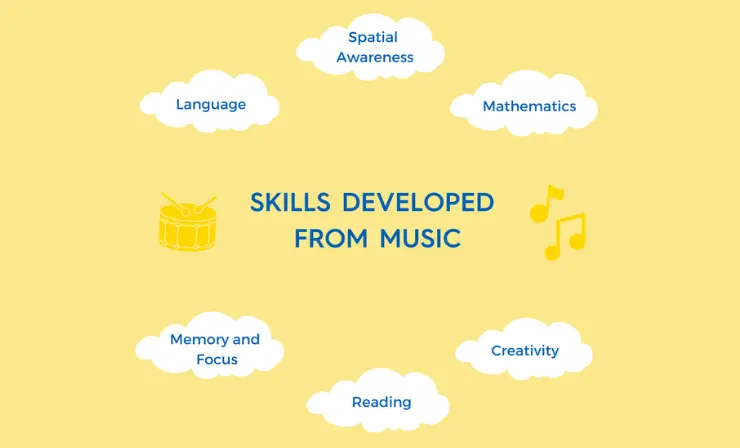
Music in the classroom offers significant benefits for auditory development and language skills, impacting students in ways that extend far beyond the music itself. Here are some key points highlighting this relationship:
- Enhanced Neural Processing of Sound: Music training strengthens the brain’s ability to process sounds. This is not just limited to musical notes but extends to different auditory inputs, crucial for language acquisition and understanding.
- Improvements in Language Skills: Research from Stanford University reveals that learning a musical instrument can improve brain processing in areas linked to language development. This suggests the potential for enhancing language and reading skills through musical education.
- Outperforming Peers in Auditory Skills: According to a Harvard-based study, children who engage in music training for three or more years demonstrate superior abilities in key auditory skills. These include fine motor skills and superior discrimination in melodic, tonal, and rhythmic aspects.
- Support for Literacy Development: Music training is closely linked to the development of language and literacy skills. As students face increasing challenges in literacy, music offers an engaging and effective method to reinforce reading and language learning.
This multifaceted impact of music training underscores its value in educational settings. By enhancing auditory processing and language skills, music education plays a vital role in overall cognitive development and academic success.
2. Long-Term Brain Development and Health
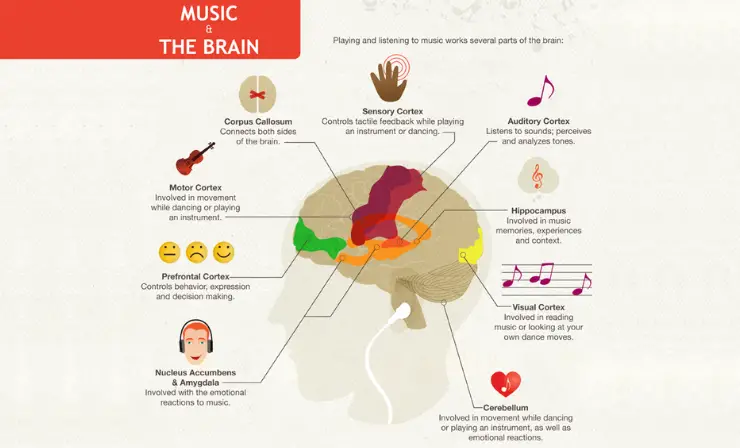
Music education in the classroom has been shown to offer long-term benefits for brain development and health, a fact supported by various studies:
- Accelerated Brain Development: A study conducted by USC neuroscientists indicates that music instruction can significantly speed up brain development. This is particularly evident in areas responsible for processing sound, language development, speech perception, and reading skills.
- Enhanced Cognitive Performance: Music training is associated with improved cognitive functions. This includes enhanced working memory and processing speed, particularly beneficial as we age. These cognitive benefits are attributed to the unique demands that music training places on the brain, such as controlled attention, memory, and self-discipline.
- Defense Against Age-Related Decline: National Geographic has reported on studies suggesting that music lessons in childhood can provide long-term benefits. These benefits include a defense against memory loss and cognitive decline in later years.
- Benefits to the Nervous System: Learning to play a musical instrument has been found to benefit the nervous system throughout life, supporting brain health even into older years.
- Social and Emotional Contributions: The social aspects of music, such as cooperation and empathy, contribute significantly to healthy aging and overall well-being.
These points underscore the profound impact of music education on long-term brain health and development. Integrating music into educational curriculums not only nurtures immediate learning skills but also contributes to sustaining cognitive health and social well-being throughout life.
3. Improved Academic Performance
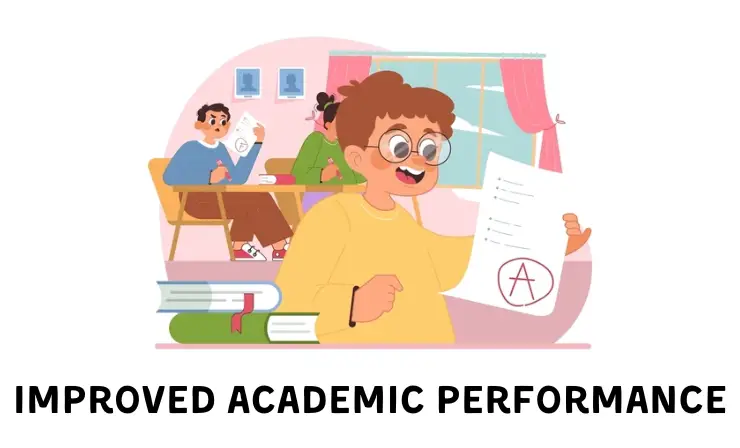
Music training in the classroom has been linked to enhanced academic performance and positive health outcomes, contributing significantly to the overall development of students:
- Improved School Grades: Students who participate in music lessons often exhibit better academic performance. Their engagement in music is reflected in higher grades across various subjects.
- Development of Positive Qualities: According to research from the Kaufman Music Center, children involved in music training tend to develop admirable personal qualities. These include being more conscientious, exhibiting openness to experiences, and demonstrating ambition and motivation.
- Cognitive Benefits: Music education enhances cognitive abilities, aiding in the development of skills necessary for academic success. This includes improved memory, attention, and problem-solving skills.
- Enhanced Focus and Discipline: Learning music requires focus and discipline, traits that are transferable to academic studies. Students who study music often show an increased ability to concentrate and maintain discipline in their schoolwork.
- Social and Emotional Health: Engaging in music can also have positive effects on students’ social and emotional health. Participating in group musical activities fosters teamwork, empathy, and communication skills.
These points illustrate the broad impact of music education, not just on academic performance but also on the overall well-being of students. By incorporating music into the curriculum, schools can provide an enriching and holistic educational experience that supports both intellectual and personal growth.
4. Emotional and Behavioral Growth
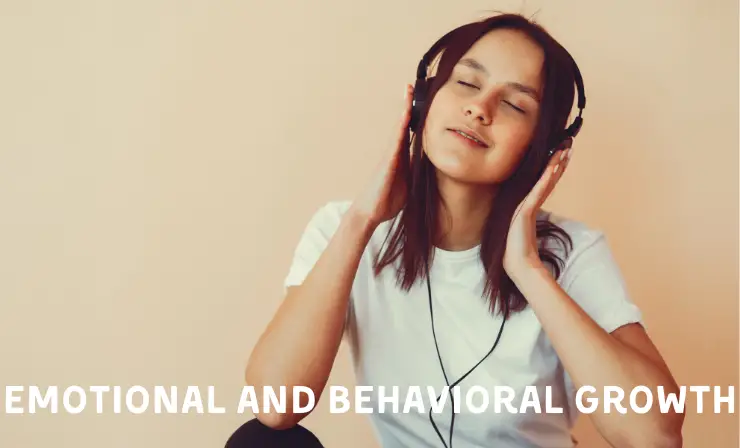
Music in the classroom plays a pivotal role in improving emotional and behavioral growth in children, as evidenced by various studies:
- Music Therapy for Emotional Maturation: Research published in the Journal of Music Therapy highlights the benefits of music therapy, especially for children with anxiety disorders. This therapy aids in emotional and behavioral maturation, providing a supportive environment for children to explore and express their emotions healthily.
- Enhancing Focus and Emotional Control: According to the University of Vermont College of Medicine, musical training helps children improve their attention span, control emotions, and reduce anxiety. This is crucial in developing coping mechanisms and emotional resilience.
- Stimulation of Emotional and Social Brain Areas: Music training stimulates brain areas responsible for emotions and social interaction, enhancing emotional intelligence. This aspect of development is supported by the social nature of musical activities, which often involve social contact and interaction, the development of empathy, and the earning of cooperative skills.
- Overall Emotional and Behavioral Benefits: Integrating music into the educational curriculum fosters not only cognitive development but also emotional growth, helping students to become more emotionally intelligent, empathetic, and socially skilled.
These findings underscore the value of music in enhancing emotional and behavioral growth in students. By integrating music into the curriculum, educators can foster a more holistic development in their students.
5. Social Skills and Cooperation
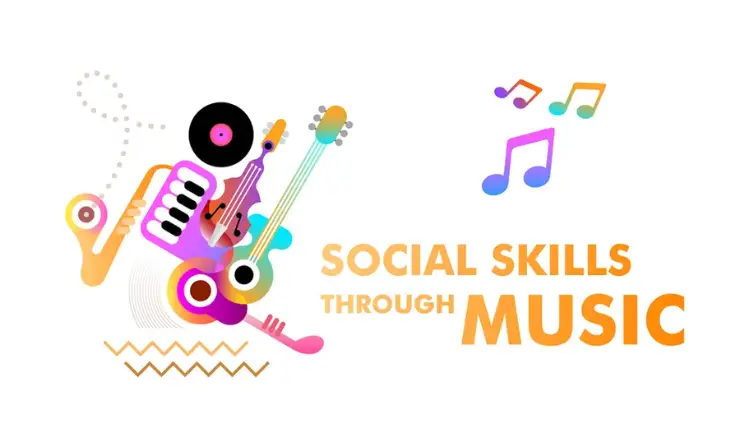
Incorporating music into classroom activities has been shown to significantly enhance social skills and foster cooperation among students:
- Promotion of Prosocial Behavior: Research underscores that music-making activities encourage prosocial behavior in children. This behavior is crucial in developing empathy and understanding among peers.
- Enhanced Peer Cooperation: Synchronized musical activities, such as ensemble playing or singing in a choir, inherently require participants to work together harmoniously. This fosters a sense of unity and teaches valuable skills in collaboration and teamwork.
- Development of Communication Skills: Music-making in groups necessitates effective communication. Students learn to listen to each other, express their musical ideas, and negotiate different perspectives, thereby enhancing their interpersonal skills.
- Building a Sense of Community: Engaging in music collectively can create a strong sense of community within the classroom. This communal experience can transcend cultural and social barriers, promoting inclusivity and mutual respect.
- Improving Conflict-Resolution Skills: Working together in musical settings can also equip students with better conflict-resolution skills. They learn to resolve differences and work towards a common goal, fostering a cooperative spirit.
- Cultivating Leadership and Responsibility: Participating in musical groups often involves taking turns in leadership roles and being responsible for one’s part in the performance. This experience is invaluable in teaching responsibility and leadership.
These benefits demonstrate that music is not just an artistic endeavor but a powerful tool for social and personal development. By integrating music into educational settings, educators can provide students with essential life skills that go beyond academic learning.
6. Stress Reduction and Emotional Well-being
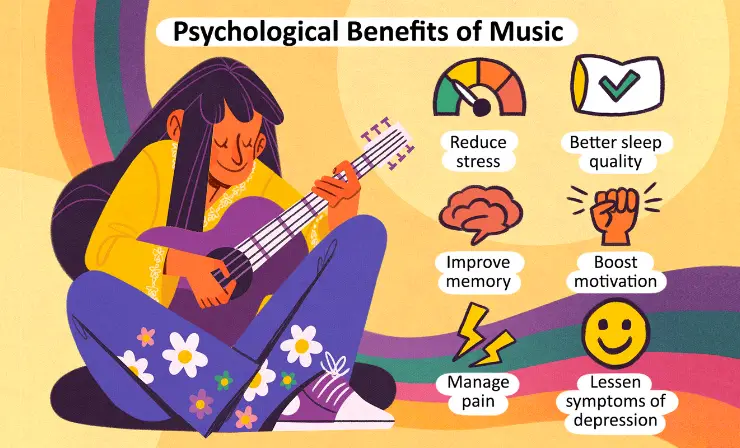
Music in the classroom serves not only as an educational tool but also significantly contributes to stress reduction and the enhancement of emotional well-being among students:
- Stress Reduction: According to Healthline, engaging with music, whether by listening or actively participating, can significantly reduce stress. This stress reduction is not only beneficial for students’ mental health but also contributes to a more positive and focused learning environment. Music’s ability to lower stress levels supports a calm and productive classroom atmosphere.
- Promoting a Positive Mindset: Music has the power to motivate students and foster a more positive mindset. This can be particularly helpful during challenging tasks or periods of high academic pressure, offering students a way to relax and rejuvenate.
- Overall Emotional Well-Being: The integration of music into the classroom thus has far-reaching effects on students’ overall emotional well-being. It not only aids in immediate stress relief but also contributes to the development of long-term coping mechanisms for emotional and mental challenges.
Incorporating music into classroom activities, therefore, offers a multifaceted approach to enhancing students’ emotional health and well-being, fostering a more engaging and supportive learning environment. These benefits extend beyond the immediate classroom experience and contribute to the development of healthy coping mechanisms and emotional intelligence in students. Music, thus, becomes a powerful tool in education, not just for its artistic value but also for its profound impact on students’ mental and emotional well-being.
7. Motor Skills and Coordination
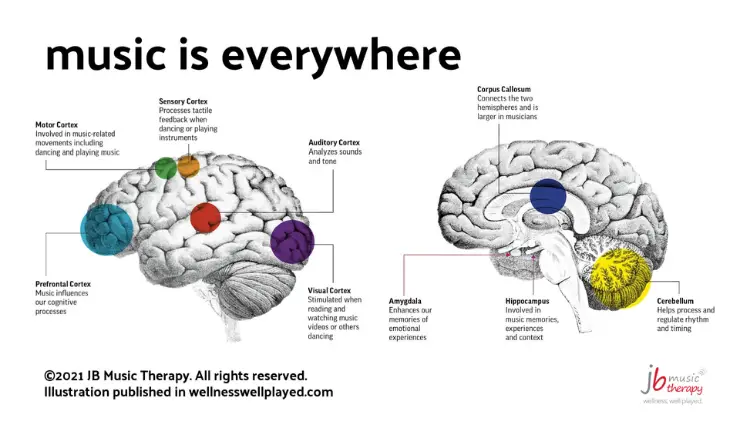
Music education in the classroom, especially through playing instruments, significantly enhances motor skills and coordination among students:
- Rapid Cortical Thickness Maturation: Instrumental practice is associated with accelerated development in areas of the brain involved in motor planning and coordination. This leads to improved fine motor skills, crucial for various academic and life tasks.
- Enhanced Visuospatial Abilities: Students who engage in music training show improvements in visuospatial abilities. This skill is vital for understanding and interacting with the spatial aspects of the world, and is beneficial in both academic and everyday life scenarios.
- Regulation of Emotions and Impulses: Learning music helps in the regulation of emotions and impulses, an important aspect of emotional intelligence and social interaction.
- Strengthening Perception-Action Link: Music production is a complex activity that requires a strong link between perception and action. This enhances both motor skills and cognitive abilities, contributing to overall brain development.
- Whole Body Learning: Music education embodies the principles of whole-body learning, integrating physical, cognitive, and emotional development. This holistic approach is key to nurturing well-rounded individuals.
These benefits underscore the value of incorporating music education into the classroom. It goes beyond mere artistic expression, contributing to the holistic development of students’ motor abilities, cognitive skills, and emotional intelligence. For more detailed insights, you can refer to the discussion on whole-body learning in music.
If using targeted strategies to incorporate music can do all of that, don’t we have a responsibility to our students to do it?
Addressing Opposing Views on Music in the Classroom
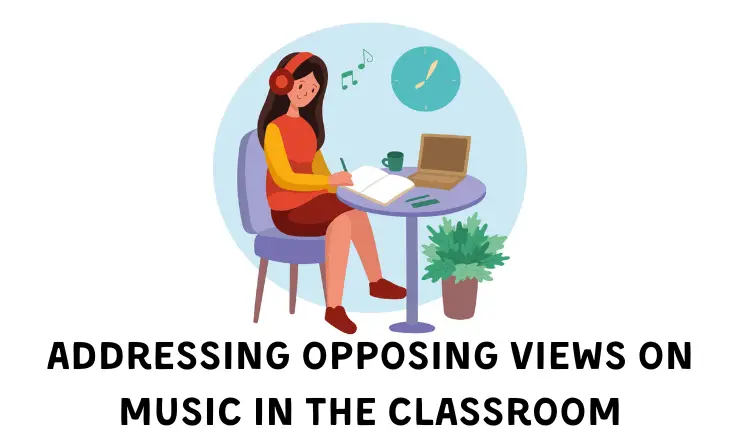
In considering the question of “should students be allowed to listen to music in class,” it’s essential to weigh the potential benefits against the concerns. This necessitates examining a range of evidence from educational studies and practices to form a well-rounded view of the impact of music on students’ learning experiences.
- Distraction Concerns: One of the main arguments against music in the classroom is the potential for distraction. However, this can largely depend on the type of music and the individual student. A study investigating the role of song lyrics found that while lyrics can be distracting during reading tasks, instrumental music or songs with less lyrical focus may not have the same effect. This suggests that the right kind of music could mitigate the distraction factor.
- Variability in Student Response: While some students may find music distracting, others may find it beneficial for their concentration and stress reduction. The impact of music on learning and concentration can vary greatly among individuals, suggesting a one-size-fits-all approach may not be effective.
- Addressing Individual Learning Styles: Acknowledging and accommodating different learning styles is crucial in education. For some students, background music can enhance focus and productivity, aligning with their auditory learning preferences.
- Use of Music as a Tool for Engagement: Music can be used strategically to engage students, especially in tasks that they find challenging or uninteresting. By allowing music, educators can tap into students’ interests and increase their motivation and engagement in the subject matter.
In conclusion, while it’s important to consider the potential downsides of allowing music in the classroom, it’s equally important to recognize its potential benefits and consider flexible policies that cater to different student needs and preferences.
5 Strategies for Incorporating Music
Of course, designing impactful instruction is much easier said than done. I’ve spoken with many colleagues who feel at a loss to know how to strategically use music in their classrooms. You might feel the same way, but I promise—it’s easier than you think!

We’ve already talked about how using background music in the classroom can be helpful for students and for improving the classroom atmosphere. The usefulness of music does not — and should not stop there.
Here are some more specific ways to use music in the classroom:
- Enhancing Storybook Listening Sessions: Listening lessons with storybooks, such as “Caps for Sale” and “Llama Llama Red Pajama,” can be enhanced with music. Playing background music that matches the story’s mood deepens engagement and comprehension, making the reading experience immersive and memorable.
- Musical Cues for Classroom Transitions: Music effectively signals transitions and establishes routines. Playing specific songs or audio cues indicates it’s time to line up, change activities, or gather materials, aiding smooth task transitions with minimal disruption.
- Music as a Memory Aid: Music is powerful for memorizing important information like the alphabet, formulas, or dates. Setting this information to a melody makes it engaging and easier to remember, turning rote learning into a fun, interactive experience.
- Music to Spark Interest in New Content: Introducing new content is more engaging when linked with music. For example, a ballad related to a historical event can spark interest in the subject, making learning more dynamic and relatable.
- Reinforcing Concepts through Music: Music reinforces existing knowledge and concepts. Having students identify rhyming patterns in songs connects and applies their understanding of language arts in a fun, interactive way, enhancing their learning experience.
As a music teacher, one of my favorite strategies is to use storybooks to make a literature connection. This can be done with beloved early childhood books like “Brown Bear, Brown Bear, What Do You See,” “Chicka Chicka Boom Boom,” and others. Seasoned music educators like Tracy King and Aileen Miracle are my go-to resources when it comes to planning a music-anchored literature lesson — they will work perfectly in any elementary classroom!

Of course, there are high-tech ways to use music in the classroom, too! Google’s Chrome Music Lab allows students to create and explore different sounds, colors, and patterns. Any one of the different available apps could be used as a structured activity or as a creative brain-break. I love using my SMART Board to have students come up and create in front of the class.
If students have good headphones available, personal devices or listening centers can be a great addition to any classroom. Document cameras are useful when it comes to projecting song lyrics and doing an interactive analysis, and students can use a countless number of apps and programs to create, edit, and manipulate music as they assemble projects and presentations.
Strategies and ideas for incorporating music in the classroom are almost endless and can be adapted to any grade level and content area. That’s the beauty of music—not only is it beneficial to students, it’s incredibly versatile!
For more ideas and strategies, check out this YouTube video!
Exploring other ways to introduce music into your preschool classroom? Check out these 16 fantastic music activities designed to spark creativity and aid in the development of your young learners.
The Mozart Effect
Addressing whether “should students be allowed to listen to music in class” in the context of the Mozart Effect is intriguing. The term refers to the idea that listening to Mozart makes you smarter…sort of. A 1993 study claimed that participants showed better spatial reasoning skills after listening to ten minutes of Mozart’s sonata for two pianos. However, because the enhancing effect only lasted a few minutes and was difficult to replicate in other studies, the results were controversial.
Still, the idea of the Mozart Effect became wildly popular—though it was later proved that listening to other types of music achieved the same outcomes. A large study done in 2006 showed that children responded even better to pop music. So, if Mozart’s music isn’t what makes students “smarter,” then what is? It seems that enjoyment and engagement are the key.
Anyone who’s been in the classroom longer than a minute knows that students respond better and work harder when they enjoy something or identify with it. I once had students do a rhythm activity with what I thought was a great song and met with mixed interest at best. The next day, I kept the activity the same, but changed the song to one that was TikTok famous—the kids went nuts, no surprise!

If we want to use music in the classroom and make the most of whatever boost the Mozart Effect can give, we need to be intentional with our selections. Delving into pop, K-pop, electronic, and international genres and artists, to find what students respond to, will greatly impact their engagement.
Some students might enjoy Mozart, of course, and it’s important to expose our students to and teach them about the great masters of old; however, choosing background music that is culturally relevant and interesting to them will not only increase their engagement but will also make them feel seen.
Useful Resources
- Is it good to listen to music while studying?
- How does music benefit your classroom or school community the MOST?
- How does listening to music affect studying?
Conclusion
I could write volumes about the benefits of music in the classroom. I wouldn’t be seven years into my career as a music teacher if it wasn’t something I believed in!
I also believe that no matter the grade level or content area you teach, this post has something that you can put in your pocket and use in your classroom. Don’t be afraid to research and customize the perfect way to incorporate music for you and your students.
For a selection of school-friendly songs and inspiration, you might want to take a look at our article, where we’ve curated a range of suitable options. May your journey to a more musical classroom be full of joy and learning!
References
- The Effects of Background Music in the Classroom on the Productivity, Motivation, and Behavior of Fourth Grade Students
- Long Term Benefits of Music Study
- 20 Important Benefits of Music In Our Schools
- At USC, Research Shows the Benefits of Music Extend From Childhood to Old Age
- Your Aging Brain Will Be in Better Shape If You’ve Taken Music Lessons
- The Benefit of Musical Training on the Aging Brain
- The Power of Music Education
- How can integrating music into your classroom benefit student learning and development?
- Why Music Should Be in Every Classroom
- Music and Studying: It’s Complicated
- The effect of music listening on work performance
- Whole Body Learning
- What makes background music distracting? Investigating the role of song lyrics using self-paced reading

You’ve written it so nicely, and you’ve come up with some great ideas. This is a fantastic post!
Thank you so much!